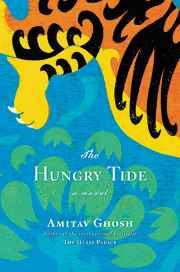
 When I heard that the setting for Amitav Ghosh's new novel, "Hungry Tide",was the elusive Sunderbans, off the eastern coast of India, I knew I just HAD to read the book. Swamps, marshes, bogs and mangroves, but especially mangroves, have always held a strange kind of fascination for me. The fact that they are so dark and foreboding with a kind of otherworldly, terrifying beauty is what draws me to them.
When I heard that the setting for Amitav Ghosh's new novel, "Hungry Tide",was the elusive Sunderbans, off the eastern coast of India, I knew I just HAD to read the book. Swamps, marshes, bogs and mangroves, but especially mangroves, have always held a strange kind of fascination for me. The fact that they are so dark and foreboding with a kind of otherworldly, terrifying beauty is what draws me to them.Upon reading the book I was pleased to find that the author has regaled us with beautiful scenic descriptions of the Sunderbans and shared tales of its fascinating history without feeling the pressure to romanticize it.
In the beginning the Sunderbans (pic. below) were nothing but forest. There were no people, no embankments, no fields. Just mud and mangrove. At high tide most of the land vanished under water. And everywhere you looked there were predators-tigers, crocodiles, sharks and leopards.
 |
Daniel Hamilton didn't make any money from this project. It was an altruistic, maybe even eccentric, move on his part for he had dreams of setting up an ideal community here: "He dreamed of a place where men and women could be farmers in the morning, poets in the afternoon, and carpenters in the evening." In other words, his intention was to create a mini Utopia.
There are three main characters in this story: Kanai,a sophisticated Delhi-based translator who is visiting the Sunderbans to collect a sealed notebook his departed uncle left him (the notebook is the vehicle that Ghosh uses to introduce to us the history of the island of Morichjhapi* which I will explain some more in a footnote)
Piya, an American born scientist of Indian descent who studies the endangered Irawaddy dolphin and,
Fokir a poor fisherman who despite being uneducated is chosen by Piya to be her guide because she trusts him implicitly and also because he knows the swamp like the back of his hand.
There is a some sexual tension between Kanai and Piya but nothing comes of it. What is beautifully expressed however, is the deep and unusual bond that is forged between Piya and the impoverished uneducated fisherman who saves her life.
Ghosh succeeds in whipping up quite the thriller with an exciting climax involving a cyclone, tigers etc. I do wish however, that his characters had had a little more---well---character! With the exception of the fisherman they seem so wooden and unemotional, and as for the dialogue, it falls positively flat a lot of the time. For example:
''So what happened after that?" Kanai said. ''Where did she go?"
''She didn't go anywhere, Kanai. She was killed."
''Killed?" said Kanai. ''How? What happened?"
See what I mean?
 |
 |
Amitav Ghosh has truly succeeded in immortalizing the Sunderbans in his book. I have no doubt that this book will generate a huge upswell of interest in the Sundarbans and its ecosystems. I, for one, would love to travel there sometime to see it.
*Morijhapi forms the most powerful backdrop to events and issues addressed in the novel. Morijhapi was declared a protected area by the Union government as part of Project Tiger launched in 1973 to preserve and protect the dwindling number of tigers in Indian forests. In 1978, the island was taken over by a group of poor and defenceless Bangladeshi refugees, seeking to set up an egalitarian world, free of maladies of class, caste, religion and poverty that had plagued them till date. But it was not to be. Clashes ensued between the State and the settlers. The Left Front government of West Bengal was determined to evict the human inhabitants in favour of its animal populace, which finally resulted in a police shoot out that killed scores of these helpless settlers and forced the rest to flee the island. The memories and memoirs of Morijhapi form a haunting prelude to the novel.
